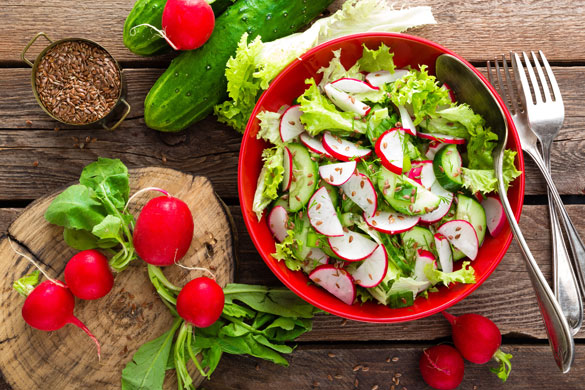Fermes Leclair et Frères Ltée.
Radish: a vegetable that deserves a better reputation!
The radish was among the first vegetables cultivated by humans. Although there is still some doubt as to its origins, it is believed to have emerged at least 5,000 years ago in the Near East or Southwest Asia, while in the Americas it dates back to colonial times.
Taking its name from the Latin radix, meaning root, it is part of the cruciferous vegetable family (Brassicaceae). According to Dr. Martin Juneau of the Montréal Heart Institute, cruciferous vegetables have excellent cardioprotective potential, as they help improve the health of our arteries. With a mildly pungent taste, refreshing, crunchy and low in calories, radishes are also a good source of antioxidants, potassium, calcium, dietary fibre and vitamin C, so you can enjoy them for their taste and texture as well as their health benefits!
While several varieties are grown in Quebec from mid-May to late October, Fermes Leclair specializes in red radish, coloured radish, the French Breakfast (two-coloured) heirloom variety (with its elongated shape, sold on leaves), and red radishes in bags.
Radish on leaves: pure freshness
We love radish on leaves for its flavour. One of the first vegetables to be sown in gardens because it resists spring frosts well, it’s also the first to appear on market and store shelves. Red radish and rainbow radish (multicoloured) are both round and taste the same; farmers also create selections of different-coloured varieties, ranging from violet to white, pink and mauve, with seed mixtures prepared to create a flavourful bouquet at harvest time that is a joy to taste as well as to look at.
French Breakfast radish is a red-and-white type with a longer shape and a milder, sweeter flavour than the round varieties—but it’s just as crunchy!


So many uses, from the root all the way to the tops
While radishes are typically eaten raw as a snack, or sliced for use in salads or sandwiches, they’re also delicious cooked in a pan with butter, steamed, barbecued, and even baked into chips (although cooking takes away much of their sharp flavour). And young radish tops are also great in salads and soups, among other recipes.
A vegetable that keeps well
Radish on leaves will keep very well in the refrigerator for at least a week. You should cut the leafy tops off, though, and store them separately: left on, the leaves will draw moisture from the root, causing it to dry out. If, despite your precautions, you find your radishes have softened a little, a plunge into an ice-water bath will help restore its vigour.

Red radish in bags

Radish packaged in cellophane is as fresh as radish on leaves, but we’ve developed a technique to further prolong its shelf life. When harvested in the field, our radishes are washed, stemmed, sorted and immersed in ice water. In addition to the bagging that prevents drying out and dehydration caused by the ambient air, this pre-chilling process helps preserve our radishes’ crisp texture. Simply rinse and enjoy!
Radish is available year-round in most of our supermarkets; during the cold season, it’s usually imported from the U.S. and Mexico.
